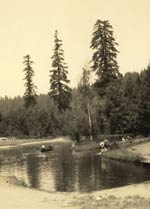 »Introduction
»Introduction
»The 1920s
»Daddy Raker
»The 1930s
»Uncle Toby
»The 1940s
»Elaine Gorham
»The 1950s
»WoHeLo Trees
»The 1960s
»Ginny Denton
»The 1970s
»Land History
»The 1980s
»Camp Directors
»Committee Chairmen
»The 1990s
»Samuel Cobb
»The 2000s
|

|
| The original three Wohelo trees |
In 1910 Charlotte Vetter Gulick, "Hiiteni" to her daughters and their friends, was
looking for a name for her family’s summer camp:
"But for long the camp had no name. Names that seemed to express the thought in the heart of the founder failed in
beauty. At last it came to Hiiteni that the things for which she wished it all to stand in the hearts of the girls
were expressed in the words Work, Health and Love. And that by combining the first two letters of each of these,
she could make a new word, ‘Wohelo,’ lovely in sound and full of the meaning she wished. The camp was named Wohelo."
-Sebago-Wohelo Camp Fire Girls
The Gulicks joined others in founding the Camp Fire Girls and the word was a gift from Hiiteni and her girls to
the new organization. Wohelo became the official Camp Fire watchword.
When campers first came to Namanu, three trees stood above all the rest at the north edge of the meadow. They soon
became known as the Wohelo trees. The Love tree was notable in that part way up, the trunk split into two. A
legend was told about young lovers from warring tribes who split the tree and pledged that if it lived then their
love would survive.
From the 1920s until the mid 1950s these three trees stood sentinel over summer after summer of camp life.
Eventually the Work and Health trees became old and weakened and needed to be taken down. In the spring of 1959,
with pomp and ceremony, three new Wohelo trees were planted on the west side of the meadow. The new trees are
Sequoiadendron giganteum, commonly known as Giant Sequoia.
The surviving member of the original trio, the Love tree, fell victim to the Columbus Day Storm of 1962. On
October 12, during the storm, the tree came down straight along the Gypsy Trail toward Pioneer, fortuitously
missing Blue Wing Lodge and the swimming pool. The stump and trunk can still be seen today along the trail at the
far end of the Blue Wing Lodge porch.
Full-unabridged text of this chapter is available in the 75th Anniversary Book which is for sale at the
Camp Fire USA Portland Metro Council's office in Portland.
©1998 Reprinting only with written permission of Camp Fire USA Portland Metro Council.
|